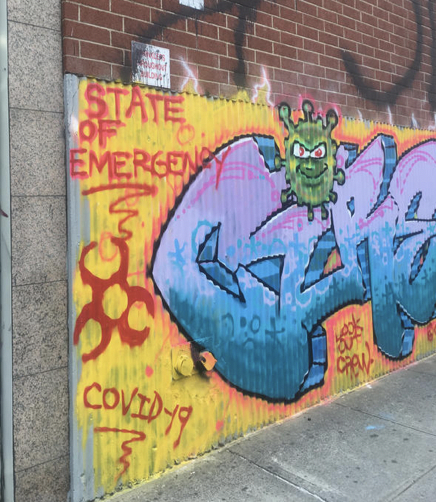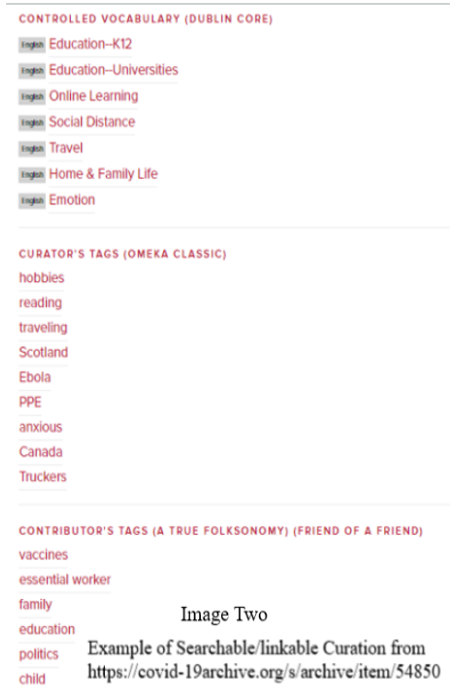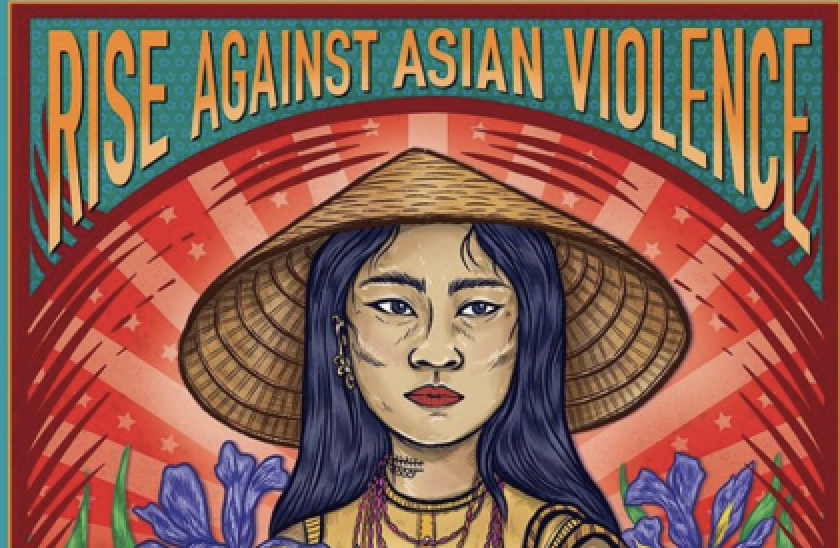Blog post by Monica Ruth
Shuttered businesses, deserted streets, and contagion among the people… elements of disarray and decay, signals and signs of the end of – or at least pause from – familiar economic and social patterns. These changes have revealed a wellspring, sparking and spawning of new life and advantageous growth in street art. During the trying times and events of the COVID-19 pandemic, artists and the public have relied on each other to take space, create space, and form art. It has been well noted that as businesses are closing, temporarily or for good, for better or for worse, for security from riots, looting, or lack of commerce in the name of public health, street art has reclaimed many of these spaces for graffiti, murals, paste-ups, chalk art, stencils, and other forms of street art. [i]
The Journal of the Plague Year (JOTPY) digital archive documents the prevalence of street art in the pandemic. As the public ebbs and flows around mandatory and recommended distancing guidelines, political discord, and concern, and social justice issues related to the killings of Black, Asian American and Pacific Islander, and other minoritized groups and individuals by US police.[ii] Having access to street art created during the unique and nuanced years of the COVID-19 pandemic, future researchers and the interested public will be able to explore how humanity reflected and pivoted.[iii]
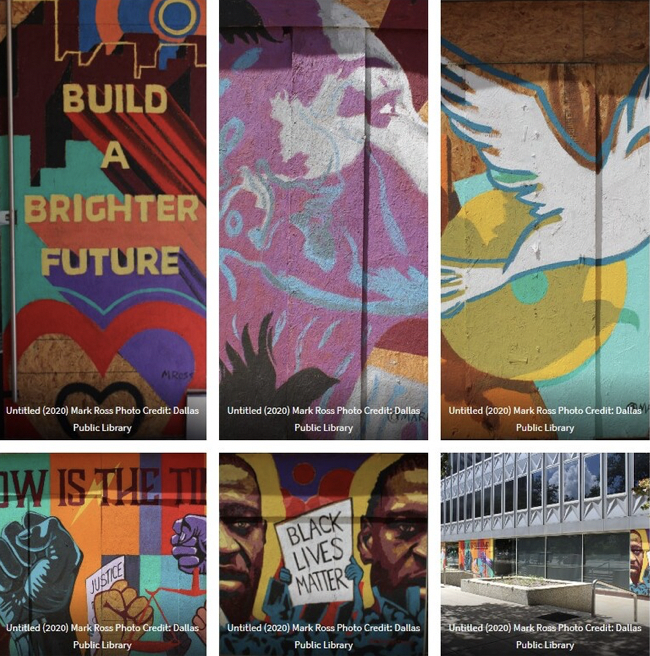
Source: James Glenn, Dallas Public Library in “Pandemic Street Art: The Black Lives Matter Movement and the Black Public Art Tradition (in three parts).” in in A Journal of the Plague Year, accessed April 14, 2021, https://covid-19archive.org/s/archive/item/42504. 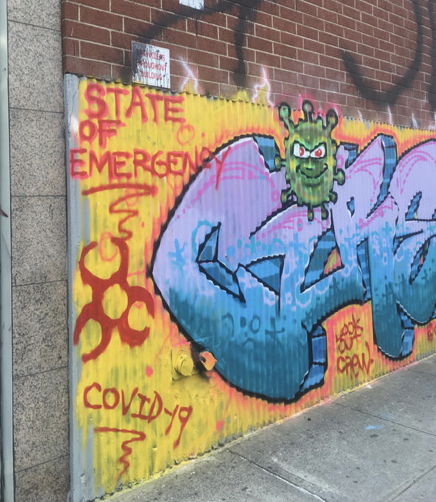
Source: Seabrook Wilson, “Graffiti on grocery story.” in A Journal of the Plague Year, accessed April 14, 2021, https://covid-19archive.org/s/archive/item/15937. 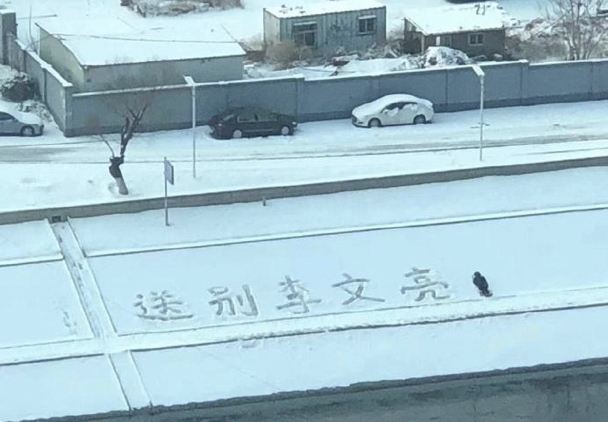
Source: “How people remember doctor Wen liang Lee in Beijing,” in A Journal of the Plague Year, accessed April 14, 2021, https://covid-19archive.org/s/archive/item/10003.
Mirror of the pandemic people
In the tagged, sprayed, bombed, splotched, pasted, and stickered walls, benches, boards, signs, streets, and poles, street art demonstrates its role as a vehicle for communication and affect. The messages conveyed are perhaps reflections of the individuals and communities from which they spring. Baruch Spinoza, Dutch philosopher, said “I believe that a triangle, if it could speak, would say that God is eminently triangular, and a circle that the divine nature is eminently circular; and thus would everyone ascribe his own attributes to God.”[iv] And as a triangular being would not only seek but identify its reflection in divinity, artists and those interacting with art are perhaps doing the same as they enact the forces of doing art. As shown through JOTPY, creators and participants “doing art” have sought out soothing familiarity through messages of hope, imagery of gratitude, and themes of social and political critique.[v]
Adjustments and acknowledgement
Art is less involved in making sense of the world and more involved in exploring the possibilities of being, of becoming, in the world. Less involved in knowledge and more involved in [the] experience, in pushing forward the boundaries of what can be experienced. Finally, less involved in shielding us from death, but indeed precisely involved in actualising the possibilities of life.[vi]
Oftentimes, street art is temporary in nature and may be removed, obscured, or destroyed. And its unique position to push social boundaries with its placement, its involvement in the landscape of a community, its messaging, and its pure existence, it has been seen as taking a Street art assumes a multitude of roles and themes: of confrontation, discovery, whimsy, creativity, disarray, degradation, and conflict with various levels of authority.[vii]
[i]Joshua Albrecht, “ Riots in the streets of Eugene, Oregon,” in A Journal of the Plague Year, accessed April 13, 2021,https://covid-19archive.org/s/archive/item/31229.
Christopher Brown, “Street art on the Commonwealth Avenue Mall – Boston, MA,” in A Journal of the Plague Year, accessed April 13, 2021, https://covid-19archive.org/s/archive/item/15574
Barbara Cytowicz, “Paste up street art, Ballarat,” in A Journal of the Plague Year, accessed April 13, 2021, https://covid-19archive.org/s/archive/item/26163.
ebtimes, “#NoJusticeNoPeace Murals Blanket Downtown Oakland,” in A Journal of the Plague Year, accessed April 13, 2021, https://covid-19archive.org/s/archive/item/20493.
Amber Evangelista, “Protect the Elderly not the 1%,” in A Journal of the Plague Year, accessed April 13, 2021, https://covid-19archive.org/s/archive/item/13073.
Laura Mullen, “The Plywood Project NOLA,” in A Journal of the Plague Year, accessed April 13, 2021, https://covid-19archive.org/s/archive/item/15938.
Youngbin Noh, “被災地でコロナの落書き 29歳男「ただのいたずら」(2020年10月6日) – Corona graffiti in the disaster area, 29-year-old man “just a prank” (October 6, 2020),” in A Journal of the Plague Year, accessed April 13, 2021, https://covid-19archive.org/s/archive/item/29331.
Melissa Pixcar, “Coronavirus Kindness: Bay Area Artists Create Murals on Boarded Storefronts to Uplift Local Communities,” inA Journal of the Plague Year, accessed April 13, 2021, https://covid-19archive.org/s/archive/item/26504.
Monica Ruth, “Sacramento artist, David Smith’s display of COVID-19,” inA Journal of the Plague Year, accessed April 13, 2021, https://covid-19archive.org/s/archive/item/39625.
Monica Ruth, “Opportunity for street art,” in A Journal of the Plague Year, accessed April 13, 2021,https://covid-19archive.org/s/archive/item/38294.
Monica Ruth, “Pandemic Street Art: Welinoo in Copenhagen – takes no responsibility,”in A Journal of the Plague Year, accessed April 13, 2021,https://covid-19archive.org/s/archive/item/41257.
Carolyn Webb, “’All we can do is paint’: How street artists see coronavirus outbreak,” in A Journal of the Plague Year, accessed April 13, 2021, https://www.theage.com.au/national/victoria/all-we-can-do-is-paint-how-street-artists-see-coronavirus-outbreak-20200420-p54lhq.html
[iii] Dana Bell, “Street Art,” in A Journal of the Plague Year, accessed April 14, 2021, https://covid-19archive.org/s/archive/item/20300.
Leslie Reagan, “Public Street art, New Jersey, USA,” in A Journal of the Plague Year, accessed April 14, 2021, https://covid-19archive.org/s/archive/item/10697.
Monica Ruth, “Pandemic Street Art: Cross-country Corona Chalk Project,” in A Journal of the Plague Year, accessed April 14, 2021, https://covid-19archive.org/s/archive/item/41787.
[iv]. Baruch Spinoza. Baruch Spinoza 1883 to Hugo Boxel. At sacred-texts.com, https://www.sacred-texts.com/phi/spinoza/corr/corr58.htm.
[v] (no author), “Stencil of Nurse Hoax,” in A Journal of the Plague Year, accessed April 14, 2021, https://covid-19archive.org/s/archive/item/38284.
Robin Keagle, “Mural by Navajo graffiti artist, Ivan Lee,” in A Journal of the Plague Year, accessed April 14, 2021, https://covid-19archive.org/s/archive/item/38770.
Carolyn Wood, “Uplifting Chalk Messages,” in A Journal of the Plague Year, accessed April 14, 2021, https://covid-19archive.org/s/archive/item/9176.
[vi]. Simon O’Sullivan. The Aesthetics of Affect: thinking art beyond representation. In Journal of the Theoretical Humanities. Volume 6 Number 3. December 2001. https://simonosullivan.net/articles/aesthetics-of-affect.pdf
[vii]. Sarah Richards. “Street Art and its Effects on a City” (PhD diss., Barrett the Honors College, 2017).
